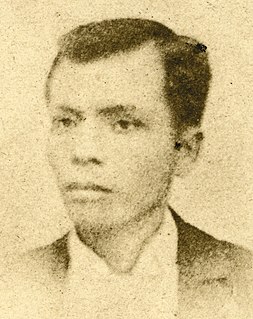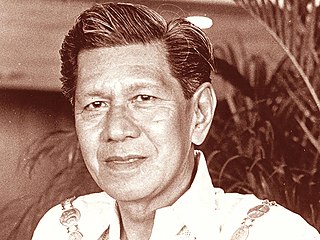
"Lupang Hinirang", originally titled in Spanish as "Marcha Nacional Filipina", is the national anthem of the Philippines. Its music was composed in 1898 by Julián Felipe, and the lyrics were adopted from the Spanish poem "Filipinas", written by José Palma in 1899.

The Katipunan, officially known as the Kataastaasan, Kagalanggalangang Katipunan ng mga Anak ng Bayan, was a Philippine revolutionary society founded by anti-Spanish colonialism Filipinos in Manila in 1892; its primary goal was to gain independence from Spain through a revolution.

Andrés Bonifacio y de Castro was a Filipino freemason and revolutionary leader. He is often called "The Father of the Philippine Revolution", and considered one of the national heroes of the Philippines. He was one of the founders and later the Kataas-taasang Pangulo of the Kataas-taasang, Kagalang-galangang Katipunan ng mga Anak ng Bayan or more commonly known as the "Katipunan", a movement which sought the independence of the Philippines from Spanish colonial rule and started the Tagalog Revolution. With the onset of the Revolution, Bonifacio reorganized the Katipunan into a revolutionary government, with himself as President (Pangulo) of a nation-state called "Haring Bayang Katagalugan", also "Republika ng Katagaluguan", wherein "Tagalog" referred to all those born in the Philippine islands and not merely the Tagalog ethnic group. Hence, some historians have argued that he should be considered the First President of the Tagalogs instead of the Philippines, that is why he is not included in the current official line of succession.

The president of the Philippines is the head of state and the head of government of the Philippines. The president leads the executive branch of the Philippine government and is the commander-in-chief of the Armed Forces of the Philippines. The president is directly elected by the people, and is one of only two nationally elected executive officials, the other being the vice president of the Philippines. However, four vice presidents have assumed the presidency without having been elected to the office, by virtue of a president's intra-term death or resignation.
"Mi último adiós" is a poem written by Filipino propagandist and writer Dr. José Rizal before his execution by firing squad on December 30, 1896. The piece was one of the last notes he wrote before his death. Another that he had written was found in his shoe, but because the text was illegible, its contents remain a mystery.

Nicomedes "Nick" Marquez Joaquin was a Filipino writer and journalist best known for his short stories and novels in the English language. He also wrote using the pen name Quijano de Manila. Joaquin was conferred the rank and title of National Artist of the Philippines for Literature. He has been considered one of the most important Filipino writers, along with José Rizal and Claro M. Recto. Unlike Rizal and Recto, whose works were written in Spanish, Joaquin's major works were written in English despite being a native Spanish speaker.
A national hero of the Philippines is a Filipino who has been recognized as a national hero for his or her role in the history of the Philippines. Loosely, the term may refer to all Filipino historical figures recognized as heroes, but the term more strictly refers to those officially designated as such. In 1995 the Philippine National Heroes Committee officially recommended several people for the designation, but this was not acted upon. As of 2007, no one had ever been officially recognized as a Philippine national hero.
Philippine literature in Spanish is a body of literature made by Filipino writers in the Spanish language. Today, this corpus is the third largest in the whole corpus of Philippine literature. It is slightly larger than the Philippine literature in the vernacular languages. However, because of the very few additions to it in the past 30 years, it is expected that the former will soon overtake its rank.

Rogelio Lunasco Ordoñez also known as Ka Roger, was a multi-awarded Filipino fiction writer, poet, activist, journalist and educator. He was one of the authors of the iconic Tagalog literature anthology Mga Agos sa Disyerto in the 1960s. He was a contributor to Liwayway Magazine, Pilipino Free Press, Asia-Philippines Leader, Pilosopong Tasyo, Diario Uno and Pinoy Weekly.

Lope K. Santos was a Filipino Tagalog-language writer and former senator of the Philippines. He is best known for his 1906 socialist novel, Banaag at Sikat and to his contributions for the development of Filipino grammar and Tagalog orthography.

The name Philippines derives from that of the 16th-century Spanish king Philip II, and is a truncated form of Philippine Islands. During the expedition of Ruy López de Villalobos to the region, the Spanish sailor Bernardo de la Torre bestowed the name Las Islas Filipinas on the islands of Leyte and Samar, in honor of the then Prince of Asturias. Despite the existence of other names, Filipinas ("Philippines") was eventually adopted as the name of the entire archipelago.
"Sa Aking Mga Kabatà" is a poem about the love of one's native language written in Tagalog. It is widely attributed to the Filipino national hero José Rizal, who supposedly wrote it in 1868 at the age of eight. There is no evidence, however, to support authorship by Rizal and several historians now believe it to be a hoax. The actual author of the poem is suspected to have been the poets Gabriel Beato Francisco or Herminigildo Cruz.

Emilio Jacinto y Dizon was a Filipino general during the Philippine Revolution. He was one of the highest-ranking officers in the Philippine Revolution and was one of the highest-ranking officers of the revolutionary society Kataas-taasan, Kagalang-galang na Katipunan ng mga Anak ng Bayan, or simply and more popularly called Katipunan, being a member of its Supreme Council. He was elected Secretary of State for the Haring Bayang Katagalugan, a revolutionary government established during the outbreak of hostilities. He is popularly known in Philippine history textbooks as the Brains of the Katipunan while some contend he should be rightfully recognized as the "Brains of the Revolution". Jacinto was present in the so-called Cry of Pugad Lawin with Andrés Bonifacio, the Supremo of the Katipunan, and others of its members which signaled the start of the Revolution against the Spanish colonial government in the islands.

José Protasio Rizal Mercado y Alonso Realonda was a Filipino nationalist and polymath during the tail end of the Spanish colonial period of the Philippines. He is considered the national hero of the Philippines. An ophthalmologist by profession, Rizal became a writer and a key member of the Filipino Propaganda Movement, which advocated political reforms for the colony under Spain.

Leonor Rivera–Kipping was the childhood sweetheart, and “lover by correspondence” of Philippine national hero José Rizal. Rivera was the “greatest influence” in preventing Rizal from falling in love with other women while Rizal was traveling outside the Philippines. Rivera's romantic relationship with Rizal lasted for eight years. She was immortalized by Rizal as the character María Clara in the Spanish-language novel Noli Me Tangere. Her original hometown is in Camiling, Tarlac.

Vida y Escritos del Dr. José Rizal, translated as "Life and Writings of Dr. José Rizal”, is a biography of Rizal written by Wenceslao Emilio Retana y Gamboa, a 19th-century Spanish civil servant, colonial administrator, writer, publisher, bibliophile, Filipiniana collector, and Philippine scholar. The 512-page book was published by Librería General de Victoriano Suárez of Madrid, Spain in 1907. It contains works of Rizal such as poems and essays in "Spanish of literary merit", some "translations and short papers" written in Tagalog, German, French, and English, and a complete listing of Rizal’s writings. The prologue for W.E. Retana’s book on Rizal was written by Javier Gómez de la Serna, while the epilogue was written by Miguel de Unamuno (1864-1936). Vida y Escritos del Dr. José Rizal is the first biographical account of the life of Rizal written by a non-Filipino author.
The Marangál na Dalit ng̃ Katagalugan is a song of the Philippine Revolution and the national anthem of the Tagalog Republic also claimed to be the first national anthem of the Philippines. Julio Nakpil composed the anthem in November 1896, but it was later on replaced by the current Philippine's official national anthem which is known today as Lupang Hinirang.

Bonifacio: Ang Unang Pangulo is a 2014 Philippine historical action drama film centering on the life of Katipunan revolutionary Andres Bonifacio. It is an official entry to the 40th Metro Manila Film Festival.
A la juventud filipina is a poem written in Spanish by Filipino writer and patriot José Rizal, first presented in 1879 in Manila, while he was studying at the University of Santo Tomas.
This is the timeline of the Philippine Revolution. It contains the events before and during the revolution.













